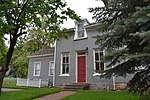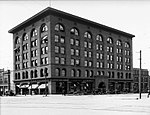Richard Vaughen Morris House
Federal architecture in UtahGeorgian architecture in UtahHouses completed in 1860Houses in Salt Lake CityHouses on the National Register of Historic Places in Utah ... and 2 more
National Register of Historic Places in Salt Lake CityUtah Registered Historic Place stubs

The Richard Vaughen Morris House is a historic house located at 314 Quince Street in Salt Lake City, Utah, was built in the 1860s, definitely by 1866. It was listed on the National Register of Historic Places in 1980.It is important as an early vernacular, adobe home updated with Federal/Georgian stylings later. It was home of Richard Vaughen Morris, a businessman and government official.
Excerpt from the Wikipedia article Richard Vaughen Morris House (License: CC BY-SA 3.0, Authors, Images).Richard Vaughen Morris House
300 North, Salt Lake City
Geographical coordinates (GPS) Address Nearby Places Show on map
Geographical coordinates (GPS)
| Latitude | Longitude |
|---|---|
| N 40.776111111111 ° | E -111.89444444444 ° |
Address
300 North 104
84103 Salt Lake City
Utah, United States
Open on Google Maps











